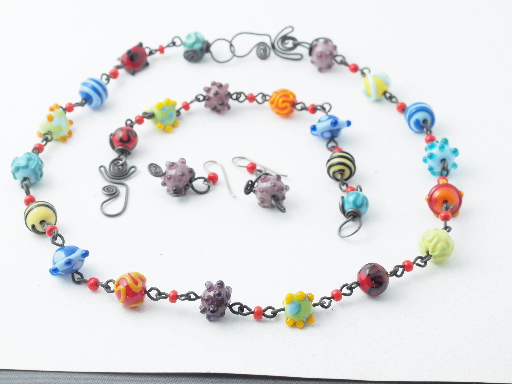So my sister in law has this dead simple braclet featuring some old style spacers—simple little opaques, with a few dots or trailing in a contrasting color, the sort of thing that got the whole lampworking movement going in the US, way back in the 70s and 80s. I thought, great, finally something that would be easy and that she'd like. I offered to make a matching necklace, she accepted, and I took a photo for reference.

On or around 26nov2005, I took a photo of this bracelet, promising that I could “easily” make a matching necklace for my sister-in-law.
Years passed.
On 18feb2010, I made a web page to remind myself to get started on this project! To be sure, one thing that held me up for a very long time was finding the wire, but eventually I did identify it; and round up a few of the little reddish-orange 8/0s in the linking components.[1]

Finally, almost exactly to the day 25nov2013, some EIGHT years later, I photographed the finished necklace, with earrings thrown in because I was so so SO late.
Obviously this was not a quick and easy project for me. The original bracelet was almost certainly made by Kelly Niemann, who has a very similar piece featured on p. 37 of Cindy Jenkins’ 1997 Making Glass Beads.[2] When I last did a search for this artist, I couldn't find any traces of her on the interwebs, so I don't know that she's still working in glass.
The original beads are for the most part very nice and round, well made, and obviously the work of a production beadmaker who doesn't hesitate to rescue her mistakes by shaping and trailing over them; the dots, frex, strand proud and are well spaced. The beads are made on quite small mandrels, perhaps 0.045/in.: this is part—but only part—of the reason they are so round, as opposed to the disk shape typical of spacers.[3]
I finally presented my sister-in-law with a bag of beads, meant to match, but not wired, so she could choose the order. She didn't care about the order, but gave me the physical bracelet (as opposed to the photo) I realized my beads didn't match very well.
Back to the drawing board.
I made lots more beads. Finally, I felt I'd spent as much time as I was willing to master these old-fashioned primary-colored “simple” spacers, and decided it was time to move on to the next step, the wire-wrapping with the black iron wire. Sara Sally LaGrand may love the stuff, but I found it a pita to use—the coating scraped off, and, being thick and iron, it was hard to bend.
Just as the beads looked dead simple to copy but weren't, the wired clasp also seemed like it would be easy to reproduce...it wasn't. Finally, after multiple struggles I gave up and called the piece done, probably finishing it sometime during the warm weather (I recall making it outside).
We got invited over during the Thanksgiving weekend, so I got off my ass, wrapped the thing & carted it over. Despite what I felt were its myriad flaws, my sister-in-law declared herself very satisfied with it. Yay.
photo 20051126; stub 20100218
[1]I only had 20 or so, but they matched perfectly. So proud...
[2]I know some people really resent beadmakers who copy things to make up matching pieces, thereby depriving the original artist of the sale. I do feel it's unethical to sell copies of other artists’ work; but to make a relative usually left cold by my stuff something they actually have a decent chance of liking, [cuz they bought the original]? Like so many other desperate artists hoping (i.e. failing) to please their circle of friends and family, I pounce. I suspect, more often than not, the relative in question agrees simply to shut the would-be artist up; so there is no sale to lose. The other case, frankly, is perhaps less defensible, and that's the relative who specifically asks you to copy something. The artist is still losing the sale cuz relative's attitude is, if you can make it, great; if not, no worries. Again, so long as no money changes hands I simply don't have a problem with this; any more than I do with someone copying a dress on her own time, which is practically a monthly feature of Threads magazine. I admit, lots of folks disagree. I happen to enjoy the challenge: for sure, this time, I'll be able to copy this this...Nope! Certainly in this case there was no danger whatsoever of my matching the quality of the original—which is basically the point of this post:)
[3]I have to admit that I wondered whether Niemann was using some sort of mold, though as I recall that sort of thing wasn't nearly as common in the 90s, before brass molds and spacer/designer beads came to dominate the market.
Unless otherwise noted, text, image and objects depicted therein copyright 1996--present sylvus tarn.
Sylvus Tarn